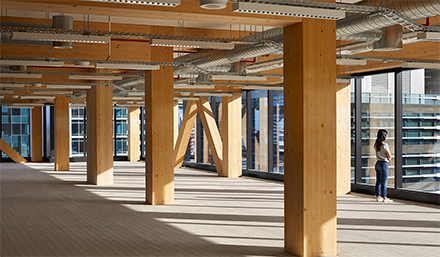Timber construction is making headlines across the world with new high-rise projects choosing this popular building material over cement and steel to reduce their carbon footprint and offer a pathway to sustainability. But how can timber construction be sustainable when you have to cut down trees to source the material? Source: Architecture & Design
A 2021 report (https://www.cefc.com.au/media/ovrkk5l3/australian-buildings-and-infrastructure-opportunities-for-cutting-embodied-carbon.pdf) by the Clean Energy Finance Corporation (CEFC) reveals that the traditional steel-and-concrete construction sector is one of the biggest contributors to carbon emissions, accounting for around 39% of total global emissions – 28% from building operations and 11% from embodied carbon in building materials and construction.
Australia’s $65-billion construction material industry alone accounts for 30-50 million tonnes of CO2-eeach year, amounting to approximately 5-10%of the national greenhouse gas emissions (GHGs).
Substitution of carbon-intensive materials such as steel and cement with low embodied carbon materials is one of the strategies being adopted to reduce the industry’s carbon footprint. Timber is an infinitely renewable resource, stores carbon (approx. 1 tonne/m³) and has very low embodied carbon. By replacing steel and concrete with timber products for instance, embodied carbon can be reduced by up to 75% (https://www.cefc.com.au/media/media-release/cefc-targets-timber-transformation-with-300-million-building-program/) according to the CEFC.
However, given the global campaign against deforestation, how will we get the timber for our buildings?
According to the Federal Government’s Department of Agriculture, Fisheries and Forestry, Australia has a total forest cover of 134 million hectares, equivalent to 17% of the country’s total land area.
While 132 million hectares (98%) are designated ‘native forests’, 1.74 million hectares are ‘commercial plantations’. More than 85% of the 32.9 million cubic metres of logs harvested in Australia each year is sourced from plantations.
A key objective of Australia’s national forest policy has been to increase the plantation timber resource ‘to expand Australia’s forest industries and offset the reduced access to native forest resource’, states the Department of Agriculture, Fisheries and Forestry. Towards this, the Federal Government has committed $86.2 million (https://www.agriculture.gov.au/agriculture-land/forestry) in the 2022-23 budget to support a 5-year program for the establishment of new plantations and help secure future domestic timber supply.
Sustainable timber is timber sourced from sustainably managed and certified forests. Applicable to both native forests and plantations, forest certification demonstrates the implementation of sustainable forest management practices and is conducted through an audit by an independent third-party certification agency.
In Australia, forests can be certified by the two major global forest certification bodies – the Program for the Endorsement of Forest Certification (PEFC) under the Responsible Wood Certification Scheme, or the Forest Stewardship Council (FSC).
Currently, 26.7 million hectares of native forests and plantations are certified under the Responsible Wood Certification Scheme, and 1.2 million hectares under the FSC.
Both forest certifi ation schemes provide chain-of-custody certifi ation, which can be used to track wood and wood-based products sourced from certified forests throughout the supply chain from the forest to the market. This provides buyers the assurance that the timber products they have purchased have originated from a sustainably managed and certified forest that practises responsible forestry.
The mass timber building movement across the world is seeing leading developers competing for the “tallest timber building” crown, with new projects announced almost every month.
A global audit of talltimber buildings (8+ storeys) conducted by CTBUH (https://www.ctbuh.org/mass-timber-data) in February 2022 yielded a total of 139 buildings that were either proposed, under construction or completed, and featured all-timber or hybrid construction methods, with Europe leading the way with 60 buildings, followed by North America (15) and Australia (8).
Having identifyed the potential to cut emissions in the building and construction sector, the CEFC announced a new $300 million program in early 2022 to encourage and accelerate the use of mass timber construction across the property industry. Seeking to transform Australia’s approach to large-scale building construction, CEFC believes the program can substantially cut construction-related emissions, providing a greener alternative to conventional construction materials.
CEFC CEO Ian Learmonth said: “Timber has been used in construction for generations. Innovations in engineered wood products have created new opportunities for mass timber construction to be used in larger projects, creating the potential for immediate and long-term environmental benefits. Our new Timber Building Program will help finance this transition by encouraging owners, developers and builders to use lower carbon engineered wood products in their projects.”
CEFC director of property investment Ryan Rathborne added: “The time is right for the development of more timber buildings across the property sector. By locking in mass timber construction in new projects, we can also help develop local skills and experience, supply chains and delivery capabilities, all of which can catalyse more timber-based building activity into the future.”
While the jury is still out on how much sustainable timber can contribute to carbon emissions reduction, the use of mass timber in construction is already delivering a slew of benefits: Engineered wood is lightweight, allowing for simple handling and machining; offers structural strength comparable to steel and concrete; enables prefabrication offsite with onsite assembly, reducing construction time and labour costs; is fire-resistant; and can be dismantled and reused in new structures.






